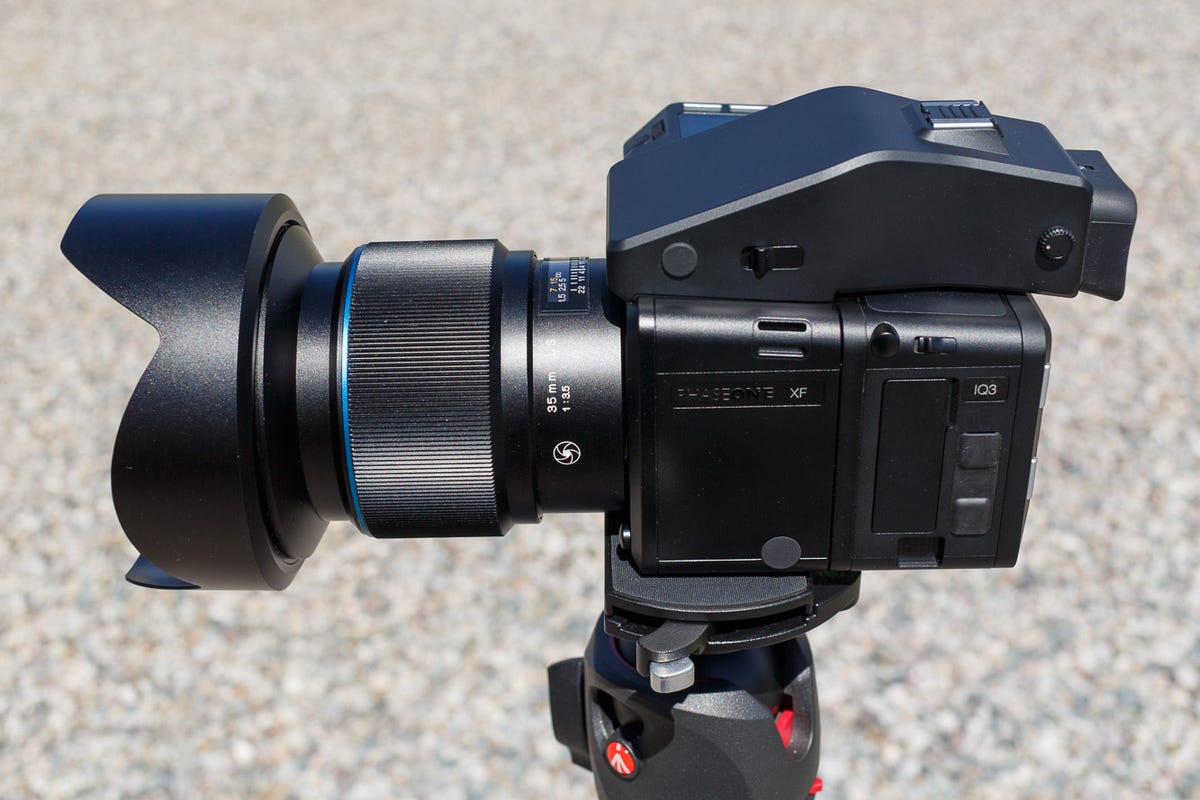
Phase One XF, IQ3 back, 35mm lens
Phase One's XF camera body adds a new autofocus system, top-mounted touchscreen and unified battery design with the IQ-series image sensors that fit onto the back. Here the XF and 80-megapixel IQ3 are shown with the Schneider Kreuznach 35mm f3.5 lens. The camera gear is aimed at professionals who need lots of megapixels for high-quality prints or large posters.
Phase One XF and IQ3 from the left
Phase One's medium-format digital cameras combine a camera body, shown in the central portion of this photo, with a digital image sensor, in this case the company's 80-megapixel IQ3. Together they cost $48,990 (€38,990, which converts to about £28,600 or AU$61,900). Lenses cost several thousand dollars more.
Phase One XF camera control screen
The standard view of the top screen shows settings. It's a touchscreen that lets you change those settings, too, though you can disable the touch so stray fingers won't mess anything up.
Phase One XF, IQ3 sensor, and 120mm macro lens
The Phase One XF camera body, with the IQ3 sensor attached at left and Schneider-Kreuznach 120mm f4 macro lens, is a formidably bulky product to handle. Part of the size here is the aluminum lens hood.
Phase One XF with 35mm lens
The Phase One XF has a deep, comfortable rubber grip. One control dial is above, near a shutter-release button. A second right-hand button is inside the grip, and a third is near the bottom of the camera front where the lens mounts.
Phase One IQ3 sensor back
The IQ3 sensor package has a touch screen that's useful for focusing macro shots and checking exposure levels. Above is the large viewfinder, which shows 97 percent of the shots the camera captures. At right on the XF camera body are two of the control dials that can be easily operated with your right thumb.
Phase One XF, IQ3, 80mm lens
The Phase One XF and IQ3 come packaged with lots of doo-dads: four batteries, a double battery charger, the Phase One Capture One Pro editing software, an instruction manual, cleaning wipes, cables for shooting with the camera tethered to a computer. More expensive but also included is the Schneider Kreuznach 80mm f2.8 lens.
Phase One XF and IQ3 packed up
The Phase One's Pelican case is rugged and heavy, but it's got roller wheels to help with transportation.
Phase One XF top view
The top of the Phase One XF viewfinder has a flash hot shoe, but the new camera also serves as a Profoto wireless flash controller.
Phase One XF, IQ3, 35mm lens
The Schneider-Kreuznach 35mm f3.5 wide-angle lens, with a focal length equivalent of 22mm on a conventional full-frame camera, is a very sharp lens good for landscape and architecture shots.
Phase One XF card slot
The Phase One XF body is the central part of this shot, with the IQ3 80-megapixel sensor module attached on the right side. The IQ3 can write photos to the CompactFlash memory card slot, shown with its flap open here. It also can connect to a PC with USB or FireWire cable or with 802.11n Wi-Fi networking. The digital back doesn't have an anti-aliasing filter, aka optical low-pass filter, a device that slightly blurs photos to reduce moire visual artifacts that can afflict images with fine patterns like fabric.
Phase One XF with 120mm macro lens
The Schneider-Kreuznach 120mm f4 macro lens is sharp and can focus as close as 40cm/15.8in. However, when stopped down to small apertures, out-of-focus backgrounds can show pentagonal highlight patterns.
Phase One XF seismograph
The Phase One XF includes a seismograph that shows when vibrations have died down enough that it's safe to shoot. You can also set a shutter release delay -- I used the 4-second default -- that helps avoid vibrations from handling the camera.
Phase One XF configuration options
The OLED touchscreen on top of the Phase One XF has a wide range of customization options.
Phase One XF status report
Photographers can check the status of various camera elements with the top screen.
Phase One XF, IQ3, 75-150mm lens
The Phase One XF and IQ3 here are shown with the Schneider Kreuznach 75-150mm f4.0-5.6 telephoto zoom. This versatile and sharp lens has an equivalent focal length range of 47-93mm on a conventional full-frame SLR.
Phase One XF and IQ3 box
The camera gear is protected within the waterproof case. It has a pouch on the lid for cords, memory cards, filters and other flatter items.

